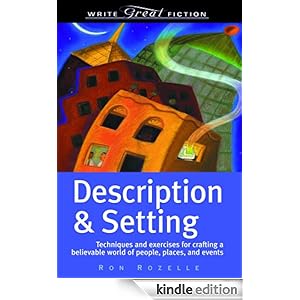 |
| Great Book for Beginners |
It's funny. I spent a lot of my writing time in university -- those snatches of time between classes and exams -- describing things. Tiny details of setting and atmosphere that I scribbled into notebooks. I sketched out short stories that revolved around incidents that could not really be call plot but were rather long descriptions of landscape with a few events, barely related to each other, in between. So when I started on the manuscript for RoboNomics, I figured that description was not my weakness. I poured all of my efforts instead into understanding the fundamentals of a good plot. But lately, because it's been pointed out to me that my settings are generic and lacking in detail, I begin to remember my first 'novel'.
My first novel, written when I was in the fifth grade, was 37 pages long. And it was more of a plot synopsis or outline than it was an actual novel. It was all story. First, this happened. Then, that happened. Then something else happened. Et cetera right up until I wrote 'The End'. Thinking back to that, it seems that my natural state is storytelling. It's a relief to realize that I have what it takes when it comes to the meat of a novel. But now I really do have to work on getting the potatoes just right.
As you may have cottoned on already, when I write I am all about systems. I have a tendency towards absentmindness and forgetfulness which can be disastrous when writing. Especially when focusing on description since it's all in the details. So I need to rely on a system.
 |
| Dollar Store Beauties |
Part I: The first part of the system involves carrying around tiny notebooks and pens wherever I go. This is very important. And it involves paying attention. I have to admit that I've got out of this dual habit in the past five years or so and it's contributed to my settings being vague and wishy-washy. But it is a habit I had earlier in life, when I was a little less cynical. The good thing about always being on the lookout for interesting details and then figuring out how to describe them is that you'll never be bored.
Part 2: Next I use a system that I read about in the book "Description & Setting." What you
do is make a chart with seven columns. The first column will be the name of the place in the story where some action takes place. And then onto the next six:
1. Sight: Visual details, obviously. This comes first since humans are primarily visual. Duh.
2. Smell: Scents add quite a bit to a scene. Strongly tied to memory for us and thus extremely evocative. I think that if nothing else, you should describe setting using this first two categories. But that's still pretty bare bones, isn't it?
 |
| Setting Chart |
3. Taste: I guess taste is next because it is tied to smell. Sometimes when I'm describing a place in which no eating will take place, I fill this column with the 'taste' associated with the way the place smells. Does that make sense?
4. Hearing: Apparently not as important as Sight and Smell -- but this is, I have to admit, my favorite column. Adding description of sounds makes a scene three dimensional for me.
5. Touch: I always have trouble with this sense. I have to really stretch myself to imagine what walking on certain surfaces feels like, what the wind is like that day or whatever. Because what if my characters never touch anything in the scene?
6. Intuition: This is an interesting one that the book recommends, and a challenge. That sixth sense -- as in -- you're not going to feel the same in a sunny park as in a dark house, right?
Anyways, so that's what I'm working through now. Some of my scenes are places I've actually been to and some are imaginary places. I have more trouble in writing about places I've been to. That's actually when I need this chart the most. Thank god for Google Maps and Google Earth, reminding me of little details that I've forgotten. And YouTube, which is helpful in looking up what certain things in the world actually sound like. I'd say too bad we don't have Smellovision, but it's pretty damn easy to remember what things smell like (brain structure being what it is). The challenge with scents is trying to describe them adequately and poetically.
The Point
The point in making these charts is not to use every detail in the descriptions of a setting. The charts are time consuming, yes, but very important. In jotting down details, I can not only more fully imagine my story world but while I am getting those details on paper a lot of times passages of description will suggest themselves to me.
What do you think? Do you have a system for description like mine? Or do you just use notebooks as a repositories of detail that you can always return to?
Ok, bye. P.S. Two days until NaNoWriMo 2013! Excitement! :)

No comments:
Post a Comment